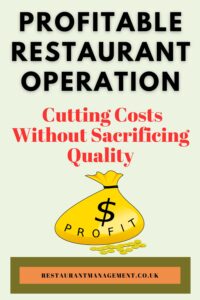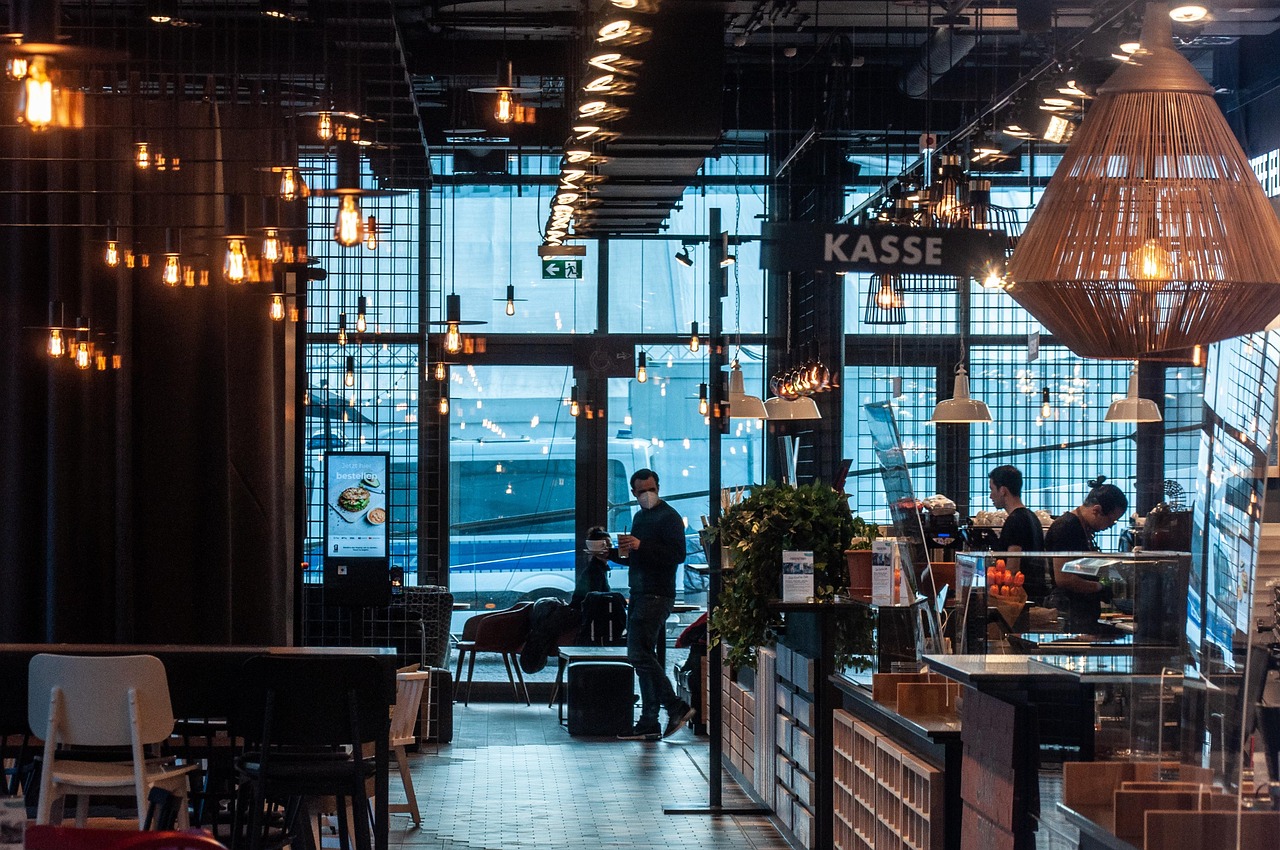Running a Lean, Profitable Operation Restaurant
Is your restaurant’s profit margin shrinking, revenues stagnating, or expenses going up? It is time to make a dramatic strategic adjustment to face these difficulties straight on. Implementing new ideas can help you reinvent your route to success and thrive in a difficult economic climate!
Running a lean and profitable restaurant requires more than simply trying to achieve more with fewer resources; it involves astutely maximising the value of every asset at your disposal. Let’s explore new ways to strengthen your business and make it thrive!
This approach can be a game-changer for your business. It offers clear methods that you can use right away to cut costs, utilise resources more effectively, and maintain high service quality for your customers. Focus on reducing labour costs, improving relationships with suppliers, and reducing waste. There are practical solutions that can minimise financial results.

Cutting Costs Without Sacrificing Quality or Morale
Managing Staff Costs While Keeping Morale High: The Balancing Act
Labour costs are a significant portion of a restaurant’s expenses. If staff are overburdened or scheduling is problematic, income can suffer. Reducing human expenditures does not have to imply diminishing employee morale. Your staff are crucial to the success of the business; disengaged employees can result in poor service, unfavourable customer experiences, and, eventually, a drop in revenue.
So, how do you trim labour costs without sacrificing quality?
1. Embrace smart scheduling and flexibility
To increase efficiency, your restaurant should focus on predicting customer demand rather than simply optimising timetables. By analysing previous sales, prioritising weather changes, and planning for planned events, your restaurant may better manage its labour while maintaining service quality. This strategy allows restaurant managers to maximise resources and implement better organisational This strategy allows them to maximise resources and implement better organisational techniques.
Establishing a dynamic scheduling system is essential for effectively managing last-minute changes.
Modern scheduling software such as Deputy or 7Shifts can significantly improve a restaurant’s ability to forecast customer demand. Knowing what customers want is essential! Managers can avoid the problem of having too many team members during slow times by being proactive in adjusting personnel numbers to guarantee they have the ideal amount of workers on hand. In this way, neither an insufficient number during peak times nor an excessive number during slack periods can keep everyone engaged and productive. As people become more balanced and able to deal with changing demands, operational efficiency and service delivery improve.
Cross-train staff in multiple roles, such as front-of-house and kitchen tasks, so that you can shift resources around and increase efficiency and flexibility.

2. Implement Performance-Based Incentives
A disengaged workforce can significantly reduce productivity, resulting in higher labour costs for companies. To boost employee productivity, performance-based incentives can be an effective solution. Rewarding employees for an organisation’s successes, such as upselling, meeting sales targets, or improving service times, helps managers encourage them to excel in their jobs. This method can result in enhanced efficiency and reduced expenses in general.
To effectively use this approach, set clear and measurable goals for employees. Reward top performers with bonuses, extra time off, or other benefits. This fosters an environment of responsibility and ownership within the team. It not only raises employee Recognition, but also helps reduce labour costs for the organisation.
3. Improve Staff Retention to Reduce Recruitment Costs
High employee turnover can be costly. It involves expenses related to hiring new staff and training them. Instead of organising new employees, it’s better to focus on improving employee satisfaction to keep them longer. A stable team is usually more experienced, efficient, and effective. Your staff is not just a resource, but an integral part of your business. By valuing and retaining them, you can build a stronger and more successful team.
To address this issue, restaurant managers should strive to create a positive work environment. They can achieve this by providing regular feedback, offering training, organising team-building activities, recognising and rewarding employees for their work, and showing appreciation for their efforts. These actions help build a more committed workforce.
Streamlining Supplier Relationships: Building Partnerships
Suppliers play a crucial role in recognisability beyond merely providing food and drink; they are partners in your business journey. Accepting suppliers’ prices and terms without question can lead to excessive expenses. By fostering strong and transparent relationships with your suppliers, you can lower costs and enhance the quality of the ingredients you receive.
1. Negotiate for Better Terms
If your restaurant has been working with a supplier for some time, it’s worth revisiting the terms of the agreement. Negotiation is key – and don’t be afraid to ask for discounts, better payment terms, or bulk buying options that work in your favour. This assertive approach can empower you, giving you more control over your business decisions and enabling you to make more cost-effective choices.
What to Do: Schedule regular meetings with your suppliers to discuss pricing, product quality, and delivery schedules. Bulk order non-perishable items, and take advantage of seasonal price fluctuations. If you’re loyal to a supplier, they may be willing to give you better deals in exchange for a long-term commitment.
2. Diversify Your Suppliers
Relying heavily on one supplier can be a costly mistake. By diversifying your suppliers, you can mitigate risks and ensure consistent product quality while maintaining competitive prices.
What to Do: Identify multiple suppliers for key ingredients. If one is offering a product at a premium price, compare it with another option and use that leverage to negotiate.
3. Buy Locally Where Possible
Local suppliers often offer better prices, higher-quality produce, and shorter response times. Building partnerships with local farmers, butchers and grocers allows you to not only save money, but also improve community links and create a regional brand, encouraging a sense of connection and responsibility.
What to Do: Build relationships with local farmers, butchers, and grocers. They’re often willing to provide discounts or offer special deals to local restaurants in exchange for regular business. Look for seasonal ingredients and reduce the reliance on long-distance supply chains.

Reducing Waste and Energy Costs: Saving Money While Being Eco-Friendly
Waste reduction isn’t just about environmental responsibility – it’s also about saving money. By reducing food waste, optimising energy use, and being efficient with your supplies, you can significantly lower costs and contribute to a more sustainable future. This not only saves you money but also makes you a responsible and eco-friendly business owner, contributing to a better world.
1. Track and Reduce Food Waste
Food waste is one of the most avoidable costs in a restaurant. Waste can escalate, draining your profits. Implementing a solid waste-reduction plan can help you identify problem areas and improve efficiency.
What to Do: Start by tracking your food waste. Identify which items are consistently wasted and consider whether they’re necessary on the menu. Repurpose leftovers where possible – turn unused veggies into soups or sauces, or use day-old bread for croutons.
2. Implement Batch Cooking for Efficiency
Instead of cooking in small portions throughout the day, batch cooking enables you to prepare meals in bulk, reduce energy consumption, and prevent food waste. This approach can also streamline kitchen operations and improve consistency.
What to Do: Cook in larger quantities during slower periods and store meals in the fridge or freezer for later use. This helps reduce preparation time, ensures freshness, and lowers energy consumption during the cooking process.
3. Reduce Energy Costs by Investing in Efficient Equipment
A significant portion of your overhead is energy costs, particularly for refrigeration, cooking, and lighting. But small changes can lead to substantial savings.
What to Do: Switch to energy-efficient appliances such as LED lighting, energy-efficient ovens, and refrigerators. Additionally, ensure that your kitchen equipment is maintained correctly to prevent costly repairs and inefficiencies. Regular maintenance helps avoid energy-draining breakdowns and extends the lifespan of your equipment.
Case Study: A Brighton Vegan Café Cuts Costs by 15% with Batch Cooking and Local Suppliers
At a popular vegan café in Brighton, the owners faced rising costs that were eroding their profits. Their food costs were high, and waste was adding up. But they turned things around with two simple strategies: batch cooking and local sourcing.
The Strategy
By using batch cooking, the restaurant prepared larger amounts of food during less busy times. This approach helped them waste less food and use less energy. They also purchased ingredients directly from local suppliers, which reduced their costs by eliminating the need for intermediaries.
The Results
- A 15% reduction in food waste and energy bills.
- Improved quality with fresher, local ingredients.
- Increased profitability despite rising costs.
This simple change cut costs and made the café run more efficiently. It enabled the café to focus on enhancing the customer experience while maintaining competitive prices.
Related articles:
Restaurant Turnaround Strategies
Restaurant Menu Pricing Strategies
Conclusion: Efficiency is the Secret to Long-Term Profit Maximise
Running a lean, profitable operation isn’t about cutting corners – it’s about working smarter, not harder. By optimising your labour, streamlining supplier relationships, and focusing on waste reduction, you’ll create an operation that runs smoothly and generates consistent profits.
The strategies outlined in this article are actionable right now, optimising all aspects, testing different approaches, and watching your profits grow as you run a more efficient and sustainable business.
Your restaurant is a living, breathing business. Use your resources wisely to reach their full potential. Focus on thriving, not just surviving. You’ve got this. Now it’s time to get to work.

FAQ’s
What is a good operating profit margin for a restaurant?
Most restaurants operate on relatively thin margins compared to other industries. When it comes to healthy business performance, operating profit margins are a key indicator. A substantial margin usually falls between 10% and 15%, showcasing a company’s ability to turn revenue into profit efficiently.
Reaching this goal not only shows good management, but it also paves the way for long-term success and growth! Full-service restaurants often see margins on the lower end of that range due to higher labour and overhead costs, while quick-service and fast-casual spots can sometimes push closer to the higher side. Anything consistently above 15% is considered excellent in the restaurant world.
What is the 30/30/30 rule for restaurants?
The 30/30/30 rule is a simple guideline used by some restaurant managers to manage costs. It suggests allocating:
- 30% of revenue to food costs (ingredients, beverages, supplies)
- 30% to labour costs (wages, benefits, payroll taxes)
- 30% to overhead (rent, utilities, marketing, insurance)
That leaves the remaining 10% as profit. While not a hard and fast rule, it provides owners with a quick way to check if their expenses are in balance.
What is the most profitable item at a restaurant?
Beverages—both alcoholic and non-alcoholic—tend to have the highest profit margins. Cocktails, wine by the glass, and soft drinks can often yield margins of 70–80%. On the food side, items like pasta, pizza, and breakfast dishes (such as eggs and pancakes) are typically very profitable, as they utilise inexpensive ingredients but can be sold at a premium. Upscale appetisers and desserts can also carry strong margins.
How to run a profitable restaurant?
Running a profitable restaurant requires a balance of great food, effective management, and sound financial discipline. A few key steps include:
- Controlling costs: Track food, labour, and overhead closely.
- Menu engineering: Feature high-margin dishes and adjust portions or pricing to maximise profit.
- Consistent service: Deliver a guest experience that keeps people coming back.
- Marketing smartly: Utilise social media, loyalty programs, and targeted promotions to establish a steady customer base.
- Adapting: Stay flexible with trends, technology, and customer preferences.
Profit doesn’t happen overnight, but with the right systems in place, it becomes much more achievable.
Happy Restaurant Staff: 20 Tips On How To Make Your Employees Happy


